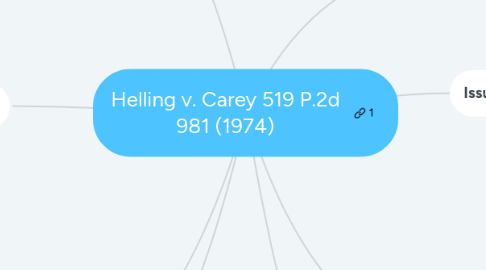
1. Rule of Law
1.1. Standard of Care for a Reasonably Prudent Physician
1.2. Negligence as a matter of law
1.2.1. Is the profession's own standard inadequate?
2. Analysis/Application
2.1. Patient (Plaintiff)
2.1.1. Standards of the profession indicate pressure tests if the patient's complaints and symptoms reveal to the physician that glaucoma should be suspected.
2.2. Physicians (Defendant)
2.2.1. Standards of the profession for this specialty for similar circumstances to not require routine pressure tests for persons under 40 years of age. Glaucoma disease rarely occurs in this age group.
2.3. Court
2.3.1. Reasonable prudence required the timely giving of the pressure test, a relatively simple and inexpensive test, to the patient, who though in the small percentage of the population under 40 with glaucoma, is entitled to the same protection as afforded to people over 40.
2.3.2. Carey's own testimony who estimated Helling's glaucoma to have been present for ten years or longer upon diagnosis, while Helling was under the care of Carey is a compelling fact for the courts consideration of liability.
2.3.3. In accordance to the question as to whether the standards of the profession are appropriate or negligent as a matter of law, the Court quoted two Justices from previous cases to support its analysis
2.3.3.1. Justice Holmes in Texas & Pac. Ry. v. Behymer: What is usually done may be evidence of what ought to be done, but what ought to be done is fixed by a standard of reasonable prudence, whether it usually is complied with or not.
2.3.3.2. Justice Hand in The T.J. Hooper: In most cases reasonable prudence is in fact common prudence; but strictly it is never its measure; a whole calling may have unduly lagged in the adoption of new and available devices...Courts must in the end say what is required.
2.3.4. The Court expanded the law of reasonable prudence to make its decision
3. Conclusion
3.1. Court reversed judgement of trial court and decision of Court of Appeals and found the defendants liable
4. Importance
4.1. The Courts analysis is important to a physician because he/she must consider each medical case on its own, and though measure each patient against the standard of care for his/her physician community, he/she must also consider other facts and indications of the patient, and be prudent at a higher level than the standard of care.
4.2. This case is also important because it put the court in the situation to determine suitable standard of care for a profession, rather than the profession itself, extensively widening the role of the court in the care of the patient (in this instant).
5. Facts
5.1. Parties
5.1.1. Barbara Helling, Petitioner (Plaintiff)
5.1.2. Dr. Thomas F Carey (and Robert C Laughlin), partners in ophthalmology, Respondents (Defendants)
5.2. What happened
5.2.1. Helling a patient of Carey, beginning in 1959, for nearsightedness. She obtained contact lenses.
5.2.2. Her next visit was in September of 1963, concerning irritation of contact lenses.
5.2.3. She continued to consult defendants nine additional times from October 1963 through October 1968, when Carey tested Helling's eye pressure and field of vision for the first time, with the resultant indication of glaucoma.
5.2.4. At 32, Helling had essentially lost peripheral vision, and her central vision was reduced
5.2.5. Helling consulted other physicians leading up to her complaint
5.3. Procedural history
5.3.1. Helling files complaint in August 1969 alleging negligence of timely tests/diagnotics resulting in severe and permanent damage
5.3.2. Trial court enters judgment for the defendants, appellate court agrees
5.3.3. Washington Supreme Court reverses judgement of trial court and the decision of the Court of Appeals
6. Issue
6.1. Did Carey comply with the Standard of Care as would a reasonably prudent physisian
6.2. Is the Standard of Care of the profession of ophthalmology appropriate for the population
7. Impact
7.1. Gates v Jensen, 92 Wash.2d 246, wherein the Plaintiff, the patient, in this case had the pressure test, which indicated high pressure in both eyes, but the Defendant did not dilate the pupils for a more in-depth exam. Court decided in favor of plaintiff, in that reasonable prudence of the physician may require a higher standard of care than is exercised by the relevant physician community.
7.2. Meeks v Marx 15 Wash.App 571, where the Plaintiff, the patient, underwent surgery and multiple follow-up treatments for broken bones, plates, and infections. Marx, the Defendant, did not diagnose Meeks with Osteomyelitis, though he suspected it, because non of the non-invasive diagnostic tests showed it. Court found judgement in Defendant, and referred to Plaintiff's of prudence higher than the standard of care of the profession as unique to each case. In this case, there was too many sharply conflicting medical testimony.
8. Influence
8.1. Influenced the ophthalmology practice of giving pressure tests at all regular eye examinations.
8.2. Doctors consider the option of providing diagnostic tests that may seem "unnecessary" in the standard of care, if the tests are noninvasive, simple, and cost effective, and symptoms indicate a possible need, even if the situation of the patient would preclude them from being a standard case.
8.2.1. This can/had led to more defensive medicine, including unnecessary tests and costly diagnostics... which in turn influences how Payors have become more involved in approving diagnostics and treatment.

